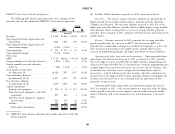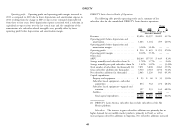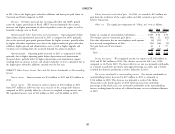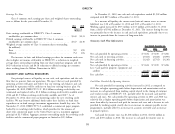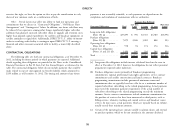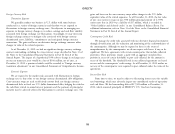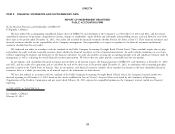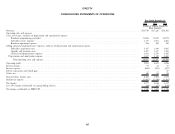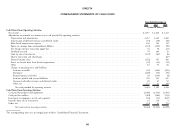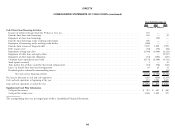DIRECTV 2012 Annual Report Download - page 76
Download and view the complete annual report
Please find page 76 of the 2012 DIRECTV annual report below. You can navigate through the pages in the report by either clicking on the pages listed below, or by using the keyword search tool below to find specific information within the annual report.DIRECTV
(d) Capital lease obligations includes obligations under the contract for the lease Note 2 of the Notes to the Consolidated Financial Statements in Part II, Item 8 of
of the ISDLA-1 and ISDLA-2 satellites currently under construction for this Annual Report.
DIRECTV Latin America, which we expect to account for as a capital lease at Income Taxes. We must make certain estimates and judgments in determining
the time the satellites are placed into service. For further discussion, please provisions for income taxes. These estimates and judgments occur in the calculation
refer to Note 21 of the Notes to the Consolidated Financial Statements in of tax credits, tax benefits and deductions, and in the calculation of certain tax
Part II, Item 8 of this Annual Report. assets and liabilities, which arise from differences in the timing of recognition of
revenue and expense for tax and financial statement purposes.
OFF-BALANCE SHEET ARRANGEMENTS
We assess the recoverability of deferred tax assets at each reporting date and
As of December 31, 2012, we were contingently liable under standby letters of where applicable, record a valuation allowance to reduce the total deferred tax asset
credit and bonds in the aggregate amount of $167 million primarily related to a to an amount that will, more-likely-than-not, be realized in the future. Our
judicial deposit in Brazil for the ECAD matter discussed in Part I, Item 3 of this assessment includes an analysis of whether deferred tax assets will be realized in the
Annual Report, and insurance deductibles. ordinary course of operations based on the available positive and negative evidence,
including the scheduling of deferred tax liabilities and forecasted income from
CONTINGENCIES operating activities. The underlying assumptions we use in forecasting future taxable
For a discussion of ‘‘Contingencies’’, see Note 21 of the Notes to the income require significant judgment. In the event that actual income from
Consolidated Financial Statements in Part II, Item 8 of this Annual Report. operating activities differs from forecasted amounts, or if we change our estimates
of forecasted income from operating activities, we could record additional charges
CERTAIN RELATIONSHIPS AND RELATED-PARTY TRANSACTIONS or reduce allowances in order to adjust the carrying value of deferred tax assets to
their realizable amount. Such adjustments could be material to our consolidated
For a discussion of ‘‘Certain Relationships and Related-Party Transactions,’’ see financial statements.
Note 19 of the Notes to the Consolidated Financial Statements in Part II, Item 8
of this Annual Report. In addition, the recognition of a tax benefit for tax positions involves dealing
with uncertainties in the application of complex tax regulations. Judgment is
CRITICAL ACCOUNTING ESTIMATES required in assessing the future tax consequences of events that have been
recognized in our financial statements or tax returns. We provide for taxes for
The preparation of the consolidated financial statements in conformity with uncertain tax positions where assessments have not been received. We believe such
accounting principles generally accepted in the United States requires management tax reserves are adequate in relation to the potential for additional assessments.
to make estimates, judgments and assumptions that affect amounts reported. Once established, we adjust these amounts only when more information is available
Management bases its estimates, judgments and assumptions on historical or when an event occurs necessitating a change to the reserves. Future events such
experience and on various other factors that are believed to be reasonable under the as changes in the facts or law, judicial decisions regarding the application of existing
circumstances. Due to the inherent uncertainty involved in making estimates, actual law or a favorable audit outcome will result in changes to the amounts provided.
results reported for future periods may be affected by changes in those estimates.
The following represents what we believe are the critical accounting policies that Contingent Matters. Determining when, or if, an accrual should be recorded
may involve a higher degree of estimation, judgment and complexity. Management for a contingent matter, including but not limited to legal and tax issues, and the
has discussed the development and selection of these critical accounting estimates amount of such accrual, if any, requires a significant amount of management
with the Audit Committee of our Board of Directors, and the Audit Committee judgment and estimation. We develop our judgments and estimates in consultation
has reviewed our disclosures relating to them, which are presented below. For a with outside counsel based on an analysis of potential outcomes. Due to the
summary of our significant accounting policies, including those discussed below, see uncertainty of determining the likelihood of a future event occurring and the
56


